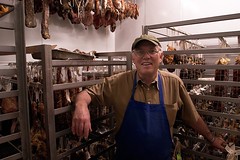
When I was a kid, I loved salami. If us kids were lucky, we’d get it sliced thin from the local deli and I’d stack it high with a ½ inch thick slab of cream cheese on white bread. A snack. Or else I’d just hack off giant hunks a salami, peel off the paper and eat them one after the other. And it was always Gallo Dry Salame (estranged younger brother of Ernest and Julio). It’s not like we had a choice; it was the only brand in town. Gallo Salame and Spam were pretty much all I knew about cured meat products for the first couple decades of my life.
Then in the early-90s, I became aware of the term charcuterie. You know, that trendy food craze that’s only been around since the 15 th century. I remember going to this Frenchy place in West Hollywood, Mimosa, and being dazzled by their charcuterie plate with its crock of mustard and the little cornichons. The rest of the food was not that remarkable but I’d never seen such a variety of pork products. Fat-speckled saucisson sec, aspic coated pâtés, pork rillettes, and other forcemeats I was too intimidated to ask about. I still don’t know much about French cured meats but that didn’t stop me from smuggling seven sausages when I went to the Dordogne a few years ago. La-di-da, aren’t I worldly?
These days, I never hear the word charcuterie. The new hip term seems to be salumi. Same thing, different country. And two names seem to be growing in ubiquity: the first is Paul Bertolli. A former executive chef at Chez Panisse, he latched onto Alice Waters’ slow food/local produce concept and pushed it to the geekiest levels. For example, he’s got a tasting database of 300+ tomato varieties and he mills his own flour for his pasta. I'm guessing he got beat up a lot as a kid. His book is amazing and also completely unrealistic for the home cook. I just don't see myself curing olives in lye anytime soon. But I’m glad that someone nerds out to the extent he does. He started curing his own meats in his restaurant basement for his restaurant, Oliveto, and then refined his techniques to where he created Fra’ Mani, a salumiere that distributes to restaurants and fancypants markets.

It’s very Whole Foods-y – sustainably raised pigs, no antibiotics, handcrafted, etc. Frankly, while it’s fantastic stuff, I haven’t had it enough to differentiate between their Salametto and the Salame Gentile and the Salame Toscano. They all have pork and salt and spices and wine and they all taste delicious. Clearly I need to eat more of it to appreciate their subtle differences. Please feel free to send me a gift order or two.
The other big name I keep hearing is the unimaginatively named Salumi Cured Meats. Started in Seattle by a retired aerospace engineer, they, too, adhere to traditional, artisanal techniques. They achieved prominence as the founder is the father and salumi provider of my culinary hero, Mario Batali. But make no mistake, its success is because of its dedication to quality, not nepotism. I’ve had everything from their guanciale, made from pig jowls, to their lardo, mouth-melting strips of pork fat and it’s all spectacular. But again, I think I need to sample much more of their offerings before I can truly make an informed judgment.
 Armandino Batali
Armandino Batali
I should emphasize that I'm kinda talking out my butt. I'm just a consumer who has done no actual market research. I have no idea if these salumieres are making an impact on anyone besides myself. But there is no denying that salume is a significant culinary trend. Just last month my sister brought me some stunning fennel pollen salame made at a hotel restaurant in Seattle. I’ve never tasted salami that was so bold and meaty and at the same time complex and subtly layered. It lasted maybe two days.
The other porcine revelation I had was when I tasted La Quercia prosciutto. I read about it in the New York Times and was skeptical. How could a product from Iowa be better than the Italian DOC-controlled original? But just like Napa’s Chateau Montelena beat out Bordeaux in 1976, La Quercia has been hailed as being better than its Old World counterparts. Herb and Kathy Eckhouse, basically smartypants academics, spent years learning the art of prosciutto curing in Parma before returning to the States to ply their trade.
Made from sustainably raised pigs – some from organic and Berkshire pigs (aka Kurobuta) – the meat is buttery and flavorful and the salumiere has a steady hand with the salt (the only other ingredient besides pork). The prosciutto slices are luscious; as sweet as they are salty. It is a completely different product than the overpriced, oversalted, German junk you get in the plastic packages at Trader Joe’s. Nothing against the Germans, but it’s a crime that they call that prosciutto.
So last weekend when my friends canceled dinner plans at the last second, I wasn't too bummed as I got to eat all the La Quercia prosciutto and Fra’ Mani Salame Toscano myself. Breakfast? Why not have a few shavings of salami? Afternoon snack? Why not have a couple slices of life-affirming prosciutto? And I’m not ashamed to say it: I chopped up the last three slices of prosciutto along with a handful of frozen peas to go with the Kraft mac & cheese I had for lunch. It was sublime.
No comments:
Post a Comment